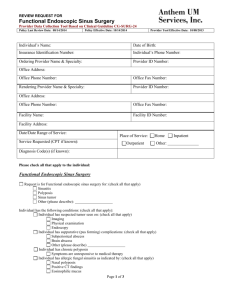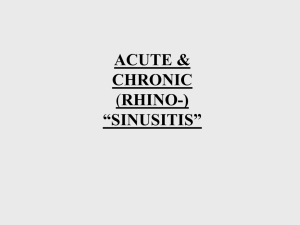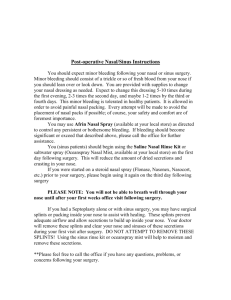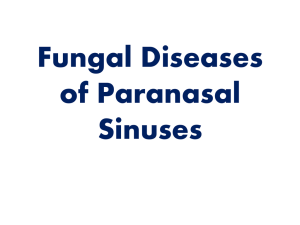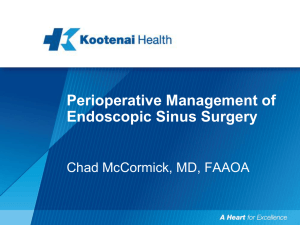DIAGNOSIS AND MANAGEMENT OF RHINOSINUSITIS
advertisement
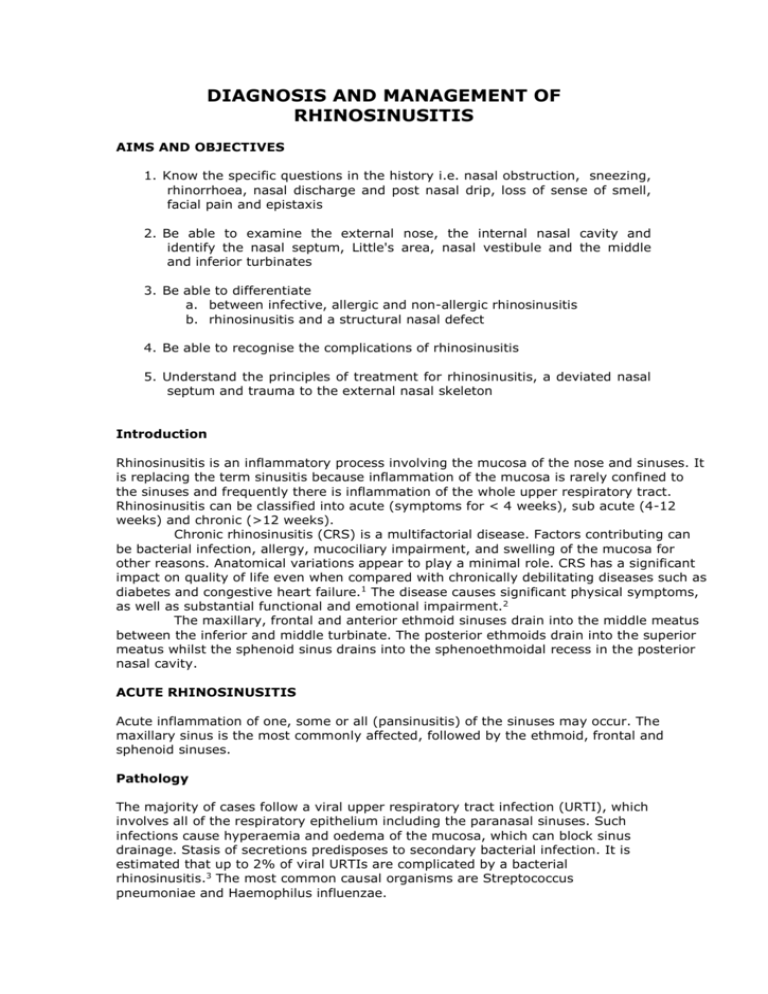
DIAGNOSIS AND MANAGEMENT OF RHINOSINUSITIS AIMS AND OBJECTIVES 1. Know the specific questions in the history i.e. nasal obstruction, sneezing, rhinorrhoea, nasal discharge and post nasal drip, loss of sense of smell, facial pain and epistaxis 2. Be able to examine the external nose, the internal nasal cavity and identify the nasal septum, Little's area, nasal vestibule and the middle and inferior turbinates 3. Be able to differentiate a. between infective, allergic and non-allergic rhinosinusitis b. rhinosinusitis and a structural nasal defect 4. Be able to recognise the complications of rhinosinusitis 5. Understand the principles of treatment for rhinosinusitis, a deviated nasal septum and trauma to the external nasal skeleton Introduction Rhinosinusitis is an inflammatory process involving the mucosa of the nose and sinuses. It is replacing the term sinusitis because inflammation of the mucosa is rarely confined to the sinuses and frequently there is inflammation of the whole upper respiratory tract. Rhinosinusitis can be classified into acute (symptoms for < 4 weeks), sub acute (4-12 weeks) and chronic (>12 weeks). Chronic rhinosinusitis (CRS) is a multifactorial disease. Factors contributing can be bacterial infection, allergy, mucociliary impairment, and swelling of the mucosa for other reasons. Anatomical variations appear to play a minimal role. CRS has a significant impact on quality of life even when compared with chronically debilitating diseases such as diabetes and congestive heart failure.1 The disease causes significant physical symptoms, as well as substantial functional and emotional impairment.2 The maxillary, frontal and anterior ethmoid sinuses drain into the middle meatus between the inferior and middle turbinate. The posterior ethmoids drain into the superior meatus whilst the sphenoid sinus drains into the sphenoethmoidal recess in the posterior nasal cavity. ACUTE RHINOSINUSITIS Acute inflammation of one, some or all (pansinusitis) of the sinuses may occur. The maxillary sinus is the most commonly affected, followed by the ethmoid, frontal and sphenoid sinuses. Pathology The majority of cases follow a viral upper respiratory tract infection (URTI), which involves all of the respiratory epithelium including the paranasal sinuses. Such infections cause hyperaemia and oedema of the mucosa, which can block sinus drainage. Stasis of secretions predisposes to secondary bacterial infection. It is estimated that up to 2% of viral URTIs are complicated by a bacterial rhinosinusitis.3 The most common causal organisms are Streptococcus pneumoniae and Haemophilus influenzae. Clinical features Acute rhinosinusitis (ARS) is usually readily diagnosed clinically. It commonly follows an acute viral URTI, with a severe, unilateral pain over the infected sinus, malaise, and pyrexia. Other symptoms include nasal obstruction, mucopurulent rhinorrhoea and poor smell. Acute facial pain without nasal symptoms is highly unlikely to be due to ARS. Pain developing in the cheek or upper teeth, usually indicates maxillary sinus involvement and as mentioned, it tends to be unilateral. Frontal sinusitis produces pain above the eye and tenderness of the supraorbital margin. Sphenoid infection may produce retro-orbital pain or pain at the vertex of the head, but pain can be referred to the temporal region or to the whole head. Tenderness on percussion of the upper first or second molar raises the possibility of a rhinosinusitis of dental origin. If there is periorbital swelling then this may be due to a periorbital cellulitis or abscess. This is a serious condition as the sight can be in jeopardy and an urgent referral is warranted as intravenous antibiotics and drainage may be required. Anterior rhinoscopy using an auriscope (ask the patient to mouthbreathe to stop the lens from misting up) may show inflamed or oedematous nasal mucosa and mucopurulent secretions in the nasal cavity. Throat examination may reveal mucopurulent secretions in the posterior oropharynx. Investigations Investigations are rarely necessary in uncomplicated cases. There is no clear evidence that the culturing of purulent secretions contributes to the management of ARS. 4 Plain sinus x-rays often show sinus opacification or a fluid level in the sinus but are rarely necessary. Treatment Patients can try simple analgesics, steam inhalations, and a decongestant. The decongestant may reduce nasal oedema and improve the natural drainage of the sinuses. It can be given topically (xylometazoline spray), but not for more than 5 days in order to avoid rhinitis medicamentosa (a condition where the nasal vasculature becomes habituated and damaged by the sympathomimetic action of the drug resulting in rebound congestion and chronic nasal obstruction). Patients often expect to be prescribed an antibiotic but there is only a 3% difference in the cure rate even after just one week, in patients with ARS whether they use antibiotics or not.5 Clinicians must weigh the benefits of antibiotic treatment against the potential for adverse effects and antibiotic resistance. In severe cases, or where symptoms are persisting or progressing, antibiotics are recommended.4 In acute maxillary sinusitis there is limited evidence, but this supports the use of Penicillin or Amoxicillin for 7 to 14 days. 6 If there is no improvement after 3 to 5 days or in areas where penicillin resistance is high, alternatives such as amoxycillinclavulanate, cefuroxime7, or doxycycline4 may be considered. When to refer and Surgical Treatment ARS usually responds to medical treatment. However, if there is progressive pain the sinuses may need draining with either a maxillary sinus washout or trephining of the frontal sinus and an urgent referral to an ENT surgeon is needed. Symptoms and signs of potential complications requiring immediate referral include periorbital cellulitis, severe headaches, focal neurological signs and symptoms of meningitis. CHRONIC RHINOSINUSITIS Chronic inflammation of the sinuses may follow an ARS or have a more insidious onset. The condition is over diagnosed as facial pain is often incorrectly thought to be sinogenic, the sinuses can only be examined using a nasendoscope, and sinus x-rays are not specific. The incidence of chronic infective rhinosinusitis in the U.K. has decreased because of the improvements in the general health of the population, diet, hygiene and the introduction of antibiotics. However the incidence of chronic non-infective rhinosinusitis due to eosinophilic inflammation has increased. CRS can be debilitating for patients and has been shown to significantly impair quality of life but this can be rectified with treatment. The disease imposes a major economic cost on society in terms of direct cost as well as decreased productivity.8 Pathology The microbial pathogens present in chronic infective rhinosinusitis are significantly different to those in ARS. Staphylococcus aureus, coagulase-negative staphylococcus, anaerobic and gram-negative bacteria predominate. In the majority of patients with CRS frank purulent infection cannot be found although mucosal hyper-reactivity to staphylococcal superantigens has been proposed as the cause in the subgroup who develop nasal polyps. Many patients have hypertrophic mucosa with tenacious secretions and at histology the lining is replete with eosinophils yet there is no evidence of allergy as we understand it (Type I IgE mediated hypersensitivity). Very occasionally, sinusitis can be secondary to dental disease and the organisms are anaerobic producing a foul smelling discharge. Clinical features Patients with chronic rhinosinusitis have nasal obstruction and commonly a discoloured discharge (nasal or post-nasal) for longer than 12 weeks. They may also experience a smell disturbance (anosmia or cacosmia = unpleasant smell) or intermittent frontal pain. Many patients, with facial pain or headaches incorrectly believe they have sinus trouble. This is often reinforced by the medical profession. However, CRS is usually painless. Key points in the history of sinogenic pain are: an exacerbation of pain during an URTI, an association with rhinological symptoms, pain that is worse when flying and a response to medical treatment.9 Facial pain or pressure on its own without nasal symptoms or signs is highly unlikely to be due to rhinosinusitis and an alternative diagnosis such as midfacial segment pain, migraine, cluster headaches and atypical facial pain should be considered. Vascular pain, such as in cluster headaches, can be associated with autonomic rhinological symptoms such as nasal congestion and clear rhinorrhoea due to vasodilatation of the lining of the nose, and this can lead to an incorrect diagnosis. Traditionally, an increase in the severity of pain on bending forward has been considered diagnostic of sinusitis, but this finding is non-specific and can occur with many other types of facial pain.9 Patients should have a history of purulent secretions around the clock. Some discoloured nasal or post-nasal discharge in the mornings can occur with snorers whose clear nasal secretions (we all produce about half a cup a day) collect in the nasopharynx and become discoloured with the commensals that collect there. This is common and not indicative of a CRS. The diagnosis of CRS is largely based on the history, but physical signs such as mucosal swelling, inflammation and discharge are needed to make the diagnosis. Anterior rhinoscopy using an auriscope can be performed but viewing the middle meatus is difficult. Nasendoscopy achieves much better visualization but is not readily available in general practice. Signs such as inflammation, mucopus, or the presence of nasal polyps help confirm the diagnosis. Inferior turbinates are often mistaken as a nasal polyp but are red and sensitive rather than the pale, pendulous, opalescent painless swellings characteristic of a polyp. Patients can also be asked to blow their nose to look for evidence of mucopurulent secretions in their tissue. Patients with an allergic rhinitis have nasal obstruction and may have hyposmia, nasal irritation, and sneezing. They often have a slightly yellow nasal mucus due to staining with eosinophils but this is not indicative of active infection. On examination they classically have pale and swollen turbinates though the mucosa can be red. Patients with an idiopathic rhinitis (non-infective, non-allergic) also complain of nasal obstruction and clear rhinorrhoea or post-nasal discharge but itching and sneezing are less common than in allergic rhinitis. CRS, allergic rhinitis and idiopathic rhinitis can occur concurrently. Investigations Plain sinus x-rays are insensitive and of limited usefulness for the diagnosis of rhinosinusitis due to the number of false positive and negative results. Guidelines from the Royal College of Radiologists recommend that plain films of the sinuses are not routinely indicated. Treatment The principle aims of treatment are to ventilate the sinuses and restore mucociliary clearance. If a diagnosis of CRS is made, a trial of medical therapy should be tried. 4 A course of broad-spectrum oral antibiotics, such as amoxycillin-clavulanate, clindamycin or a combination of metronidazole and a penicillin is given for at least 3 weeks. 7 Topical nasal steroids such as betamethasone drops (2 drops, left+right tds) should be given for 2 months followed by a steroid nasal spray. Nasal drops are best taken whilst the patient is lying on the bed with the head upside down over the edge. In addition, instructions on nasal douching (see below) should be given. It is unusual for patients’ symptoms not to respond to medical treatment. Other co-existing pathologies such as allergic rhinitis or nasal polyps should be treated accordingly e.g. allergen avoidance, antihistamines, and oral steroids. Topical steroid therapy can be continued beyond eight weeks if there is an improvement. When to refer and Surgical Treatment If there is no improvement after eight weeks medical therapy, consider referring the patient to an ENT specialist (Fig. 7). Patients should undergo nasendoscopy to confirm the diagnosis. In persistent cases that have not responded to maximum medical treatment, a CT scan of the paranasal sinuses with a view to surgery may be considered. In Functional Endoscopic Sinus Surgery (FESS), the natural drainage pathways of the sinuses are cleared, to allow adequate drainage and resolution of the CRS. Treatment outcomes show a mean 91% improvement rate10 and it is now the preferred technique in sinus surgery rather than the classical 'open' surgical approach. Patients are advised that they will often need to continue to take topical nasal medication after surgery as many of the causes of CRS are due to a systemic disease affecting the nasal lining. It is like ‘asthma of the nose’ and indeed many of the patients have co-existing late onset asthma. Summary Chronic infective rhinosinusitis tends to be over diagnosed. Many patients do not have an active infection but have developed a persistent allergic rhinitis due to perennial allergens. Other common causes of CRS are patients with mucosal hypertrophy or polyps associated with late onset asthma who often have hyposmia and yellow stained secretions due to eosinophils. Chronic infection is associated with green secretions throughout the day along with nasal obstruction and this usually responds to the correct anti-bacterial treatment. Patients with facial pain or pressure without any nasal symptoms rarely have CRS, and their pain is usually neurological in origin. The commonest cause of facial pain is midfacial segment pain, a symmetrical sensation of pressure, sometimes described as ‘blockage’ but without any airway impairment that affects the face and/or forehead. It is like tension type headache except that it affects the midface. It responds to low dose amitriptyline, taking 6 weeks to work and needs 6 months of treatment.11 Nasal Douching Mix ½ teaspoon of salt, ½ teaspoon of sugar and ½ teaspoon of bicarbonate of soda in 2 pints of boiled water, which has been left to cool. Place some of the mixture into a saucer, or draw some mixture up with a syringe. Block off one nostril with one finger and then sniff or squeeze up the solution into the other nostril, letting it run out afterwards. Topical sprays and drops should be taken after douching. COMPLICATIONS OF INFECTIVE SINUSITIS Can be serious and life threatening They include: Chronic sinusitis Osteomyelitis Peri-orbital cellulitis and orbital abscess Commonest serious complication Direct or blood-borne spread Ethmoid sinuses separated from orbit by thin plate of bone (lamina papyracea) Ethmoiditis can be associated with: cellulitis i.e. inflammation of skin anterior to orbital septum ‘pre-septal cellulitis’ orbital abscess whereby pus is subperiosteal (confined by periosteum of lamina papyracea) but posterior to orbital septum Management Peri-orbital cellulitis is treated by high dose antibiotics and careful observation An orbital abscess puts the vision at risk from pressure on the optic nerve and requires urgent drainage This can be prevented by careful monitoring of: colour vision (this is the first sign of danger) visual acuity eye movements If in doubt a CT scan of the sinuses should be requested urgently Facial cellulitis May be an extension of: orbital cellulitis frontal sinusitis or where the pus spreads into the soft tissues of the forehead ‘Pott’s puffy tumour’ maxillary sinusitis or osteomyelitis Is treated with high dose antibiotics and sinus drainage as necessary Usually form as a late complication of acute sinusitis Collections of sterile mucus occupying an obstructed sinus (especially frontal and ethmoidal) Present with facial swelling, visual disturbances due to displacement of eye or secondary infections Treatment is by surgical drainage (usually endoscopic) Mucoceles Intracranial complications Can occur by direct spread, by venous thrombophlebitis or along the perineural tissue of the olfactory nerve Meningitis is the commonest complication Cavernous sinus thrombosis o Due to spreading thrombophlebitis from the frontal, ethmoidal and sphenoid sinuses o There is decreased venous return from the eye causing the orbit to swell and congestion of the retinal vessels o Symptoms include high fever with rigors, severe headache, reduced level of consciousness and cerebral irritation o Signs include IIIrd, IVth, VIth nerve palsies causing opthalmoplegia in addition to paraesthesia of the upper two divisions of the Vth (due to the close proximity of these nerves to the cavernous sinus) o Frequently the symptoms become bilateral o Treatment is with high dose antibiotics but there is still a high associated mortality Brain abscesses secondary to frontal sinusitis o occur most commonly in the frontal lobe o may cause subtle changes in personality, headaches a grand mal convulsion or may be found incidentally on a CT scan o treatment requires neurosurgical drainage or aspiration Extradural abscess secondary to frontal sinusitis o May be found on CT scan and is usually due to a dehiscence of the posterior wall of the frontal sinus o Are usually drained into the frontal sinus and hence externally Subdural abscess secondary to frontal sinusitis o Is difficult to diagnose in early stages o Patients have general malaise, headache and some neck stiffness and signs of raised intracranial pressure o The diagnosis is generally made on the examination and CT scan o The prognosis of this rare complication is poor Acknowledgements We would like to thank Dr Ko, Dr Poon and Mr Foundling-Miah for their comments and suggestions. References 1. Gliklich RE, Metson R. The health impact of chronic sinusitis in patients seeking otolaryngologic care. Otolatyngol Head Neck Surg. 1995;113:104-9. 2. Senior B, Glaze C. Benninger M. Use of the rhinosinusitis disability index in rhinologic disease. Am J Rhinol 2001;15:15-20. 3. Agency for Health Care Policy and Research. Diagnosis and treatment of acute bacterial rhinosinusitis. Evid Rep Technol Assess (Summ) 1999;9:1-5. 4. European Position Paper on Rhinosinusitis and Nasal Polyps Rhinology 2005:supplement 18. 5. De Bock GH, Van Erkel AR, Springer MP, Kievit J. Antibiotic prescription for acute sinusitis in otherwise healthy adults. Clinical cure in relation to costs. Scand J Prim Health Care. 2001;19:58-63. 6. Williams JW Jr, Aguilar C, Cornell J, Chiquette E, Dolor RJ, Makela M, Holleman DR, Simel DL. Antibiotics for acute maxillary sinusitis. Cochrane Database Syst Rev 2005;4. 7. Brook I. Microbiology and antimicrobial management of sinusitis. J Laryngol Otol. 2005; 119:251-8. 8. Adult chronic rhinosinusitis: Definitions, diagnosis, epidemiology, and pathophysiology Otolaryngology-Head and Neck Surgery 2003;129:1-33 suppl. 9. Jones NS. Sinogenic Facial Pain: Diagnosis and Management Otolaryngologic Clinics of North America 2005:In press 10. Terris MH, Davidson TM. Review of published results for endoscopic sinus surgery. Ear Nose Throat J 1994;73:574-80. 11. Jones NS. Midfacial Segment Pain: Implications for Rhinitis and Sinusitis. Current Allergy and Asthma Reports 2004;4:187-192.
